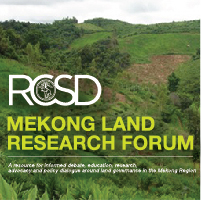Location
The purpose of the Mekong Land Research Forum online site is to provide structured access to published and unpublished research on land issues in the Mekong Region. It is based on the premise that debates and decisions around land governance can be enhanced by drawing on the considerable volume of research, documented experience and action-based reflection that is available. The online site seeks to organise the combined work of many researchers, practitioners and policy advocates around key themes relevant to the land security, and hence well-being, of smallholders in Cambodia, Laos, Myanmar, Thailand and Vietnam.
The research material on this site is mounted at three levels:
First, a selection of journal articles, reports and other materials is provided and organised thematically to assist researchers, practitioners and policy advocates to draw on one another’s work and hence build up a collective body of knowledge. This is the most “passive” presentation of the research material; our contribution is to find and select the most relevant material and to organise it into key themes. In some cases the entire article is available. In others, for copyright reasons, only an abstract or summary is available and users will need to access documents through the relevant journal or organisation.
Second, a sub-set of the articles has been annotated, with overall commentary on the significance of the article and the research on which it is based, plus commentary relevant to each of the key themes addressed by the article.
Third, the findings and key messages of the annotated articles are synthesised into summaries of each of fourteen key themes. For each key theme, there is a one-page overall summary. Extended summaries are being developed progressively for each theme as part of the Forum's ongoing activity.
Overall, we intend that this online site will contribute toward evidence-based progressive policy reform in the key area of land governance. We further hope that it will thereby contribute toward to the well-being of the rural poor, ethnic minorities and women in particular, who face disadvantage in making a living as a result of insecure land tenure.
Members:
Resources
Displaying 471 - 475 of 564Foreign Direct Investment (FDI) in Land in the Lao PDR
TAKEN FROM WEBSITE INTRODUCTION: This study by GTZ on behalf of BMZ about FDI in land highlights dramatic increase in land concessions, based on data collected in two provinces for an inventory, which GTZ conducted as no official data on land concessions is available. The Lao PDR is a small land-locked country in South-East Asia with a total area of 236,800 m2 with over 80% mountainous surface. It is estimated that all together concessoins for 2-3 million hectar land were granted, representing 13% of Lao PDR's total land area.
Rubber Production in Northern Laos: Geographies of Growth and Contractual Diversity
ABSTRACTED FROM INTRODUCTION: Lao PDR is the least densely populated country in Asia and has long been remote and isolated from the rest of the continent. This role has only recently begun to change. The geographic location of Laos between the booming economies of Thailand, Vietnam, and China has led to the perception of Laos as a potential crossroads of the tightly integrated GMS an organization promoting trade, tourism, and development between countries through which the Mekong River runs. However, this is a role it has been somewhat reluctant to accept.
Crop choice, farm income, and political control in Myanmar
Myanmar's agricultural economy has been under transition from a planned to a market system since the late 1980s and has experienced a substantial increase in production. However, little research is available on the impact of economic policies in this country on agricultural production decisions and rural incomes. Therefore, this paper investigates the impact using a micro dataset collected in 2001 and covering more than 500 households in eight villages with diverse agro-ecological environments.
Women’s Land and Property Rights under Customary or Traditional Tenure Systems in Five Ethnic Groups in Lao PDR
ABSTRACTED FROM SUMMARY: Many ethnic groups practice a system of land use and resource management which is uniquely adapted for upland areas. This has developed over generations as part of traditional ways of life, and is underpinned through ritual and customary practices. This study looks at how women’s land and property rights are established and maintained under these customary or traditional tenure systems. Five different ethnic groups were studied: Brao, Trieng, Hmong, Khmu and Tai Dam.


